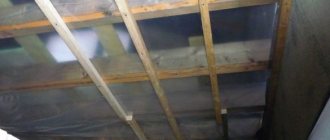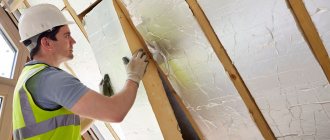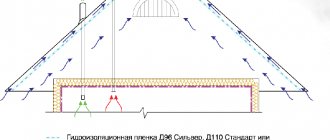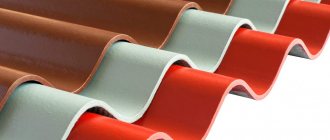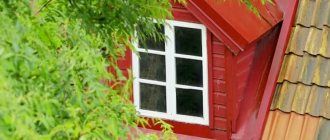The quality of insulation of the attic roof must comply with the provisions of SNiP II-3-79; the document controls the parameters of humidity and temperature in the room, taking into account the thermal conductivity of building structures and the climatic zone of the building's location.
SNiP II-3-79. Construction heating engineering. Downloadable file (click the link to open the PDF in a new window).
SNiP II-3-79
Insulation of the attic roof of a private house
Attic in a private house
What is a roofing cake for an attic roof?
Structurally, all roofs are divided into two main types:
- “cold” - do not involve installation in the attic of residential premises, the roofing cake does not include thermal insulation;
- “warm” - immediately or subsequently focused on exploiting the space under the attic as residential or utility.
Regardless of the design and architecture, for every house the roof is one of the most important functional protective and decorative elements. It protects the building from external atmospheric factors and various mechanical influences, and also prevents the outflow of heat from the building during the cold season. Heat always tends upward, and if it is not contained, heat loss through the roof alone can reach 35%, and this is a significant overexpenditure of energy resources and operating funds. To minimize heat loss, and, consequently, costs, specialized thermal insulation materials must be used during construction or reconstruction. The difference is that in the case of a cold attic, the floor is insulated, and when arranging a residential attic, both the floor and the roof slopes are insulated. When insulating the floor of a cold attic, the maximum possible layer is laid in it to prevent heat loss. In the ceiling of a warm attic, a smaller layer of thermal insulation is laid, mainly to increase acoustic comfort, while the main “line of defense” is precisely in the slopes. The attic roofing pie consists of several functional layers.
- Vapor barrier - prevents steam released as a result of vital activity from entering subsequent layers of the roof. Even impermeable films with taped joints do not guarantee absolute tightness and retain the bulk of fumes, but some amount still gets inside.
- Thermal insulation is the main functional layer formed from a specialized thermal insulation material. It prevents the outflow of warm air in cold times, overheating of the under-roof space in the hot season, and also provides acoustic comfort, which is no less important for residential premises. The thickness of the insulation is selected based on the standards for thermal resistance of enclosing structures for a specific region of residence and type of thermal insulation. For the bulk of the regions and most materials, a layer of 200 mm is considered the minimum, for the southern regions - from 150 mm.
- Waterproofing – protective membranes laid on top of insulation under the final roofing covering are also called windproof membranes. Vapor-permeable membranes prevent moisture from entering from outside, prevent convective heat transfer (weathering) and release steam from the insulation. It is removed by ventilation of the under-roof space. The use of impermeable films as waterproofing and wind protection is gradually disappearing, since their use requires the construction of two ventilation gaps: between the insulation and the film, and between the film and the roofing. Whereas the membranes are laid directly on the insulation without a gap, which simplifies installation.
The key to the energy efficiency of the design and long years of operation is dry insulation, since when moistened it does not lose its thermal insulation properties. The insulation is maintained in its original condition thanks to a vapor barrier that traps the bulk of vapors from the inside and waterproofing that prevents it from getting wet from the outside.
Insulating the attic from the inside with your own hands: video and stages of work
Each material has its own fastening characteristics and should be used exclusively in accordance with the manufacturer’s recommendations. But if we talk about the general procedure for carrying out work, then there are mandatory stages that are carried out almost always, regardless of the material chosen.
The first layer of waterproofing material is laid out, which should protect the insulation from the destructive effects of moisture. The film is overlapped so that one layer overlaps the other by 10-15 cm. The material is secured using a construction stapler, and the joints are additionally taped.
Layout of insulation in relation to the roof of the building
Then, if necessary, a sheathing is created. For it, you can use wooden slats, the width of which is 8-10 cm. They need to be attached to the rafters, positioned parallel to each other at a distance of 50-60 cm. It is very important to check each element separately, using a building level. This will prevent any roof defects from occurring in the future.
A heat insulator is placed on the rafters or sheathing and secured in a suitable manner. For example, if we are talking about using any type of wool sold in the form of rolls, then the material is cut into pieces of the required size in order to lay them between the rafters. In this case, the thickness of the insulation should be such as to correspond to the width of the log. It is especially important if you decide to insulate the walls from the inside with mineral wool plus drywall. In this case, all free space must be filled with insulation.
The top layer of this “pie” is a layer of vapor barrier material, which can be used as polyethylene film, glassine or roofing felt. As with waterproofing, the selected material is overlapped. True, in this case it is better to fasten it using thin wooden slats, placing them in increments of 40-50 cm. All joints must be taped.
Helpful advice! If you need to lay several layers of thermal insulation material, you need to lay a vapor barrier film between each of them. This is especially true for cold regions.
You can save a lot on attic insulation if you understand which materials are better and cheaper
As a final step, all that remains is to take care of a suitable finishing coating, which can be attached to the sheathing or, in the absence of it, directly to the bars. It is worth taking into account the weight of the decorative panels used, since installation of the heaviest of them may require preliminary installation of a metal profile frame.
Stone wool for attic insulation
One of the most common insulation materials in pitched roofs is stone wool, as the optimal material in terms of performance and cost. It has such properties as:
- low thermal conductivity;
- biostability;
- fire resistance;
- non-flammability;
- sound absorption;
- minimal hygroscopicity;
- durability;
- practicality (and ease of installation, and preservation of the original parameters for the entire service life).
When vapor passes through the fibers, the stone wool is not moistened, its thermal conductivity and volume remain unchanged, that is, during operation the insulation remains dry and effective and does not lose its properties.
ra093FORUMHOUSE Member
Please give advice on how best to insulate the attic of a 10x10 m timber house, Middle Urals. The pie is now standard: flexible tiles, ventilation gap 50 mm, membrane, rafters 200x50 mm. The attic is quite low, I don’t want to lower the ceiling too much.
I see options:
- 200 mm stone wool. Then straight finishing. The rafters look like cold bridges. But how much heat do they take away, considering that 200 mm, and my house itself is made of 190 mm timber, essentially like a cold bridge.
- 50 mm gap between the wool and the membrane, 150 mm of wool, there is already a 30 mm pier plate on the rafters. It turns out more expensive, but it seems to me it should be warmer than 200 mm of wool. The downside is that the ceiling will be lowered a little more.
What other options are there that are not too expensive? Of course, I would like to blow out everything with 150-200 polyurethane foam or lay it all out with slabs, but the price turns out to be very high. Can he handle the entire feast with 100 mm slabs? Judging by the advertised thermal conductivity, it will be like 200 mm of wool.
Anatoly Zemlyanko Technical specialist of ROCKWOOL company
Definitely the first option. 200 mm stone wool, which is the most effective vapor-permeable and breathable material. All other materials will act as a vapor barrier, so it is not advisable to mix these insulation materials. Logs are not cold bridges, since the thermal conductivity coefficient of wood is quite low, which indicates its effectiveness.
Brief overview of insulation materials
Before you start insulating the attic roof of a private house, you need to choose a suitable insulation for these purposes. Each type has a different number of layers and thickness of thermal insulation. There are several types of roofing thermal insulation materials for insulating the roof of an attic floor:
- Mineral wool . Certain rocks are used for its production. Among the advantages are increased fire resistance, good thermal insulation properties , maximum resistance to mold and rot. The disadvantages are large mass and moisture permeability. Thermal insulation of an attic roof using mineral wool is not only cheap, but also practical. We talked about roof insulation with mineral wool in this article.
- Glass wool . Now outdated, but still quite well-known type of material. To obtain it, glass must be melted. Has excellent thermal insulation properties . Does not absorb moisture, is not afraid of fire, insects and rotting. The disadvantages include the penetration of glass microparticles into the human lungs, which can cause serious harm to health. After some time it may begin to crumble into small particles.
- Polyurethane foam . Mainly consists of an inert gas phase. It is divided into two types - soft and hard. Very lightweight, provides high-quality insulation of heat and noise, and is not afraid of water. PPU is quite flammable. Read more here.
- Expanded polystyrene . It is polystyrene foam. Available in the form of foamed or extruded polystyrene foam. Its raw material is polystyrene granules. Pros - environmentally friendly material, lightweight, moisture-resistant, has good heat and sound insulation properties. The disadvantages include the lack of resistance to fire and the destruction of foam under mechanical stress.
Insulation technology for pitched roofs
For the most part, when the attic floor is initially planned as a residential floor, insulation is carried out as follows.
Anatoly Zemyanko Technical Specialist
When the insulation is installed before installing the waterproofing layer and roofing - the most risky, but also the most popular installation procedure in Russia.
Risky, because it is not always possible to install insulation and cover it with waterproofing in one day, and if the weather turns bad and it rains, both the rafters and the thermal insulation will get wet, which is unacceptable when insulating the roof; the thermal insulation must be dry. But even when insulating an already closed circuit, mistakes are often made. On the forum there is approximately an equal number of “What should I do?” questions asked after installing the roofing.
AGontarForumHouse Member
Help is needed. We have a country house with a 2-pitched roof (attic). On the roof (from outside to inside): corrugated metal sheet, roofing felt, sheathing, rafters. The fact that it is necessary to disassemble and make a counter-lattice is understandable, but the house is not for permanent residence, but rather a weekend cottage (spring, summer, autumn) and a couple of times in the winter, so I want to minimize costs. I need advice on what can be done to prevent the roof from rotting.
Today I see 2 options:
- fill the corners of the rafters with sheathing with 50 mm slats and stretch the membrane, then insulation;
- stretch the membrane from the inside along the rafters (leaving the thickness of the rafters as a ventilation gap), and somehow attach the insulation on top.
Anatoly Zemyanko Technical Specialist
Mount bars between the rafters to create a ventilated gap, then install a windproof membrane with a snake, and lay insulation in the free space. On top of the entire structure, make a lathing with a vapor barrier and a final coating.
kolkapFORUMHOUSE Member
Colleagues have a question, I want to make an attic, the ceiling and rafters are 50x200 mm timber, sheathing and temporary roofing material have been made, I want to cover it with metal tiles and insulate it. How to properly insulate and do it wisely?
Anatoly Zemyanko Technical Specialist
Standard roof:
- – metal tiles;
- – sheathing;
- – counter-lattice;
- – sealing tape;
- – hydro-windproof membrane;
- – self-adhesive tape;
- – logs;
- – stone wool insulation;
- – vapor barrier;
- – self-adhesive tape;
- – sheathing;
- – finishing coating.
“Classical” technology for insulating a pitched roof - in a training video.
Insulating the attic from the inside if the roof is already covered: preparing the room
An attic is not just a lived-in attic. There are some standards that distinguish these two premises from each other. First of all, the attic roof must have a slope. In addition, the height of the room established by the standard must be at least 2.5 m.
Various materials are used to insulate the attic, such as mineral wool, polystyrene foam, etc.
Focusing on the attractive appearance, many decide to arrange an attic. But in reality, you have to deal with some nuances, which it is advisable to familiarize yourself with before starting work:
- the materials that were used to build the attic directly determine further heat loss in this room. Therefore, their choice should be approached very responsibly;
- Properly selected engineering solutions, which make it possible to provide all the necessary communications on the upper floor, have no less influence;
- The shape of the roof plays a significant role. It can be single-pitch, gable or broken;
- in order to hide the load-bearing elements of the roof, you will have to use your imagination;
- the attic can be located not only on the territory of the house, but also extend beyond its boundaries, supported by columns.
Each of these aspects has its own impact on the approach that will be required for high-quality roof insulation. But the main role still belongs to two main materials - heat and water insulation. On the one hand, the space under the roof is in the coldest zone of the building. On the other hand, a strong difference between the temperature inside and outside often causes condensation to appear, which has a destructive effect on materials.
When insulating an attic, you should pay attention not only to the ceiling, but also to the walls
Efficiency of single-layer insulation
As for the method of laying insulation, for a long time there was an opinion that cross-insulation is more effective.
id1932564FORUMHOUSE Member
Tell me what to do: the roof is attic, the insulation is 200 mm in size for the rafters, I bought rolled mineral wool insulation for the roof. There is an idea to add 50 mm cross-insulation from the inside. The builders did not approve. Does this make sense? Tatarstan region.
Anatoly Zemyanko Technical Specialist
It is better to insulate in one layer than in several. Increasing the speed of work by reducing the number of technological operations, reducing waste due to cutting layers when performing run-ups.
Six fragments of walls with stone wool slabs were tested in the climatic chamber of NIIMosstroy:
- In three layers and in one layer - the plates are joined without a gap (good installation).
- Three layers and one layer - slabs with a gap of 2 mm (normal installation).
- In three layers and in one layer - a gap of 5 m (everything is bad - it needs to be redone).
A seam width of up to 2 mm is acceptable in most building structures and appears in the standards. This is due to the fact that under climatic conditions, convection at a seam of such width is not intense. Therefore, it is not detected by a thermal imager as a cold bridge. Previously, there were studies on the uniformity of two-layer and single-layer insulation while maintaining the width of the seam.
The research revealed the following:
- Single-layer and multi-layer insulation used in external enclosing structures are equivalent in their effectiveness.
- A gap of 2 mm between adjacent insulation boards has virtually no effect on heat transfer resistance.
Anatoly Zemyanko Technical Specialist
Advantages of minimizing thermal insulation layers (2x100 mm and 1x150 mm are better than 4x50 mm and 3x50 mm):
- reduction of labor costs during the preparation and installation of insulation;
- reduction of material scraps during work;
- insulation with a thickness of 100 mm or more is less prone to deflection than a thickness of 50 mm, due to which it is more securely held in the frame, which is important when installing on vertical and inclined surfaces;
- A single-layer solution is ultimately cheaper than insulation with two or more layers.
Preparing the under-roof space for insulation
You should know that, according to GOST standards, the height of ceilings in the attic cannot be less than 2.5 meters. But this does not apply to the entire area of the attic, but only to half of it, that is, in the remaining 50 percent, the height of the room may be slightly less.
What factors influence heat loss in the attic floor:
- type of main building material of the house;
- the presence of common communications with other rooms of the house;
- features of roof geometry, number and shape of slopes;
- type of load-bearing roof materials;
- placement of the attic relative to the main building (with access beyond its boundaries or not).
All these factors must be taken into account before you begin to insulate the roof from the inside with your own hands. Building regulations dictate that insulation of a house must be carried out from the outside so that the freezing point moves to its outer part. But this rule does not apply to attic floors. Here, the specifics of construction require internal insulation, since roofing material must be placed outside.
The only surface that can be insulated from the outside is the roof gable
In terms of preparation for insulation work, you need to carefully study the options for thermal insulation coating and select a high-quality waterproofing film.
Signs of a “correct” pitched roof
High-quality materials, coupled with compliance with insulation technology, guarantee a long service life of the roof without “crying” walls in the attic, mold and mildew. A properly insulated pitched roof provides a comfortable microclimate in the attic without the need to increase the power of the boiler in winter or the air conditioner in summer. You can technically verify the effectiveness of roof insulation by examining it with a thermal imager. The device will show the absence or presence of zones through which owners “drown” the street. But even without equipment in winter, the main sign of mistakes made can be seen with the naked eye - “garlands” of icicles. On a roof where the insulation is done correctly, the snow lies in a uniform mass, without melting, and there is nowhere for icicles to come from.
Features of calculations
The thermal resistance of a roof with single-layer insulation is calculated using a complex formula; it takes into account the technical characteristics of insulation, requirements for thermal protection of buildings, climatic zone of location, standards for indoor microclimate, purpose of premises and other factors. The formula is used by professional architects when creating a project.
Insulating the attic from the inside with polystyrene foam
Ordinary developers do not need to make such calculations; it is enough to use the practical recommendations of builders:
- for the southern regions of our country, the thickness of mineral wool or polystyrene foam should be within 10 cm;
- for temperate climatic regions, the thickness of insulation is at least 15 cm;
- for northern regions, the thickness of insulation is at least 20 cm.
In all cases, it is meant that polystyrene foam or mineral wool is used as insulation - these materials have the lowest thermal conductivity among all those used in construction.
Attic insulation scheme
Attic insulation calculator
Go to calculations
Dependence of insulation thickness on its thermal conductivity
Insulation of complex structural elements
If you have decided on insulation and insulation materials, congratulations! Prepare everything carefully, calculate everything you need and feel free to proceed. The main thing is to carry out installation work only in a well-ventilated area. And finally, when working with modern insulation materials, many manufacturers advise using a vacuum cleaner before insulating the attic roof from the inside, and after it is finished.
Insulating pitched and straight attic walls is not difficult, and the first difficulty you will encounter is windows and other complex structural elements. It is also important to properly insulate them, leaving no chance for moisture or water vapor to leak through. Do you know what are usually the most problematic places in attic rooms that cause mold and smudges? So take this issue seriously:
Here is another tricky moment when the attic ceiling is not made of logs, but a solid slab. You need to insulate it like this:
And finally, after insulating the attic, make sure that snow does not accumulate later in the drains and on the ridge - the entrance and exit of the movement of under-roof air. To do this, it is more rational to install ventilation pipes along the entire roof ridge, and make the ridge itself unventilated. That's all the difficulties!
Which vapor barrier to choose for the attic
Modern developers use various materials as vapor barriers:
- Polyethylene film. The material is laid during the process of creating the roof. A prerequisite for installation is the creation of ventilation gaps to prevent the formation of condensation. Evaporation of steam particles occurs when laying the rough side outward.
- Polypropylene films. The material is highly durable. When choosing a vapor barrier of this type, it is worth additionally laying a layer of cellulose or viscose on the top side of the layer. This is necessary to absorb drops of condensation.
- Reflective membranes. For such insulation there is no need to create ventilation gaps - thanks to the special structure, the material allows air to pass through and retains moisture. The membrane has high reliability and quality.
The method of fixing the vapor barrier layer depends on the type of surface. The material is attached to bricks, concrete or foam blocks using double-sided tape. On wooden surfaces, the membrane is secured with a stapler or nails. It is important to lay the vapor barrier with the smooth side into the room.
How to calculate the thickness of insulation
The roofing material of the attic does not protect against the cold and has almost zero thermal resistance. In addition, all the heat from the house is collected under the ceiling of the attic floor, so the regulatory requirements for its insulation are as stringent as for the roof itself. For example, for the Moscow region of Russia, roof insulation must have a heat transfer resistance of at least 5 m2 °C/W.
For reference. The standard values of thermal resistance are for reference; they can be easily found in the relevant documentation or on the Internet in relation to the region of residence.
To calculate the thickness, you need to know the thermal conductivity coefficient of the material λ (W/m2 °C). The values of these coefficients for different insulation materials are presented in the diagram:
For example, you want to insulate the attic of a house in the Moscow region with mineral wool. You need to take its thermal conductivity coefficient (0.045 W/m2 °C) and substitute it into the formula to calculate the thickness:
δ = R x λ, where:
- δ – thickness of the heat-insulating layer, m;
- λ – thermal conductivity coefficient of insulation, W/m2 °C.
It turns out δ = 5 x 0.045 = 0.225 m or 225 mm. This is the minimum value, and it is better to set the thickness of the mineral wool layer to 250 mm.
